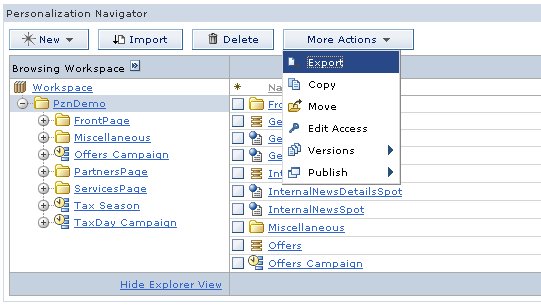Publish personalization rules
To export, publish, and delete Personalization rules on local or remote servers we can use the Personalization Navigator or the pznload script.
- Export personalization objects using one of the following methods...
- From the Personalization Navigator
-
More Actions | Export

You are prompted for a location to save a nodes file. This file contains an XML representation of all the currently selected personalization objects. We can export entire folders.
- Run pznload with --export option
-
cd wp_profile\bin
setupCmdLine.bat
cd PortalServer_root/pzn/prereq.pzn/publish/
pznload --export --out filename --serverurl url --targetpath path --targetworkspace workspace --username username --password password
- From the Personalization Navigator
- Send data to the appropriate server:
-
pznload.sh --serverurl url --targetpath path --targetworkspace workspace --username username --password password
--serverurl The URL of the remote publish servlet. If not specified, the program attempts to connect to a WebSphere Portal server running on the local machine. --targetworkspace The name of the workspace to publish to. The default workspace name on all IBM Content Manager run time edition installations is... -
ROOTWORKSPACE
--targetpath The location in the target workspace, which is the parent for the published nodes. The target path must exist before publishing. Example: If the export function was used on the folder /Projects/HR website, then the target path is specified as /Projects. So that the published resources are once again in /Projects/HR website. --username A valid user on the target system with sufficient access rights. --password The password for the user. --help
- To delete objects...
pznload --delete --username username --password password --targetpath path
To force the deletion of a personalization rule without having to respond to a confirmation message, insert the --force flag after the delete command. For example...
-
pznload --delete --username username --password password --targetpath path --force
Results
After a publish is started, we see status messages in the command console.
Parent topic: Publish personalization rules overview
Previous topic: Publish personalization rules
Next topic: Publish personalization rules over SSL